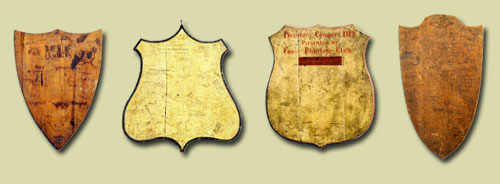
History
Above: Shields were signed by campers and staff members in the early years of the camp.
For over 100 years, Phantom Lake YMCA Camp (PLYC) has touched the lives of thousands of boys and girls from the United States and abroad. It is the oldest YMCA camp in Wisconsin and one of the ten oldest in North America. PLYC is a place where campers go to get away from the “real world”. Many people might consider PLYC to be a place, untouched by the world around it. However, that does not mean that it has not been affected by historical events and an ever-changing society. Some events affected the camp more than others, but none of them, not even the Great Depression, managed to close the camp down for an entire season. It has also changed with society, starting up new programs and ending old ones, but nothing so drastic as to give the camp a different look or feel.
PLYC has not always been at its present location in Mukwonago, WI. Nor has it always been named Phantom Lake YMCA Camp. In fact, the camp was originally called Camp Hope and was held near Menomonee Falls, WI, at Lake Five in 1893. It was not an independent YMCA camp, as it is today, but instead was under the auspices of the Milwaukee YMCA. The “Y” held camp in the same location the following year, but did not hold any camp in 1895 due to a fire at the YMCA building in Milwaukee.
In 1896, from July 6th to the 16th, thirty-six boys and ten leaders conducted camp at Lake Beulah. In 1897, the camp moved again, this time to Pewaukee Lake. However, none of the locations had been satisfactory. During the next year camp directors were trying to find a location that would prove to be satisfactory and that could be used year after year. In 1898 they found chose a campsite at Idlewile Park at Phantom Lake and since the summer of that year, camp has been conducted at the same location. The only difference now in the location is the size of the campground – it has grown much larger since 1898.
For ten years, camp was successfully held at Idlewile Point at Phantom Lake. It was during that initial period that some of PLYC’s traditions started. For example boys had tent inspection and changed activities at the sound of the bugle. The present-day campers still have tent inspection, but instead of changing activities at the sound of a bugle, they do so now with the ringing of a large bell.
For some reason, a YMCA official decided that Camp Hope was not going to be held in 1908. Therefore, W. H. Wones, State Boys’ Work Secretary, proposed that a State YMCA camp be held on Phantom Lake. In 1908, its first year as a state camp, eighty-one boys and men, mostly from Milwaukee, Kenosha, and Racine gathered at camp.
The campsite back then was small. In addition to the tents for the boys, the site had only two buildings. One of the buildings was used as Wones’ tent and camp Headquarters, and the other was used as the assembly building.
In 1912, in order to buy property and to pay for other expenses, the camp administration issued two different stock certificates. Contributions donated over $7,000 towards the purchase of the camp property. Over eighty boys secured some sort of donation, totaling $1,413.25. As a result of that fundraising campaign, the old assembly hall and dining hall were both rebuilt that year.
Up until 1911, the campers had all come from Wisconsin. It was in that year that the first boys from Illinois attended camp. From then until 1921, boys from sixteen different states, including Wisconsin, came to camp.
As World War I raged on across the Atlantic, “Y” officials still held camp but with a couple of changes. For example, special emphasis was given to “physical examinations, life-saving and first-aid examinations. In 1917, the boys had a two-acre garden at camp to grow food so they could contribute to the war effort. The next year, they used ten additional acres in the vicinity of camp to grow the food.
During the 1920s and 1930s, the administration made many improvements to camp. The big news in the brochure for the 1925 season was the new Voorhis Athletic Field and the new dining hall. The boys finally had a suitable place to hold their track meets and other athletic events. The field is still in great shape, but the track no longer exists. The addition of the new dining hall meant that boys now had a proper structure in which they could congregate and share in fellowship during meals. Unfortunately, the dining hall burned down on June 6, 1971, at 3:30 in the morning.
In 1928 Alford Lodge was added. The boys now had a specious building in which they could assemble. It became one of the biggest buildings on the campgrounds.
In addition to the new and improved buildings, the camp also changed its policy on the age of campers admitted for sessions. Up until the 1929 season, boys had to be at least twelve years old to attend camp. In 1929, the camp accepted ten and eleven-year-olds for two of the sessions. A few years later, the policy changed to allow nine-year-olds to attend camp.
Until the 1930s, only boys camped at Phantom Lake. That changed, however, with the increased demand from parents for a place for girls. They wanted their daughters to receive a similar camping experience as the boys. Therefore, camp officials contemplated about opening the camp up to them. In 1931,from August 9th to the 23rd, the first girls camp opened at PLYC. Girls had the option of attending one of the two sessions or both sessions if they so desired.
In the 1940s and 1950s, girls came to camp only in August, whereas boys came in June and July. That all changed in the 1970s when the camp administration offered the first coed session. Since then, the coed sessions have been the most popular for campers to attend.
In 1945 another improvement was introduced at the came - a drinking fountain near Alford Lodge was built. It is still used by thirsty campers today.
Four years after the first girls camp, the camp came under the control of the North Central Area Council of YMCAs, an organization that owned and ran many camps. Their reign of control covered YMCAs in five states, but no real benefits came from being a part of the North Central Area Council. The NCAC controlled PLYC for thirty-two years.
In June of 1967, the camp became part of the Waukesha YMCA. It was purchased for $75,000. In 1984, the Waukesha “Y” was planning to sell the camp and dismiss the permanent staff. To prevent that from happening, a group of people decided to buy PLYC from the “Y”, and in 1985, PLYC became an Independent YMCA. It has remained independent since then, and in 1996 it had its centennial celebration.
As the years went by, the camp survived by offering new activities to compete with different camps. During the Depression, activities such as riflery, canoeing, and sailing were added to the program. The camp also put an emphasis on non-athletic activities, with working in the craft-shop being one of the most popular ones.
One of the most important aspects of camp is religion. The focus on Christian ideals goes all the way back to the beginning of the YMCA in the mid-1840s. George Williams, influenced by the writings of the evangelist Charles G. Finney, and some of his companions, held “prayer meetings” in the evening after work. These prayer meetings eventually developed into the YMCA.
The “C” in YMCA stands for “Christian”; however, the camp has accepted campers who were not Christian. For many years, Bible Study had an important role in the boys’ religious training. Boys studied the Bible every morning after breakfast. During the 1908 season, boys had eleven Bible Study Clubs. At the end of camp, they had to take a five-question exam covering their lessons. In the 1920s, the “Y” believed that Bible Study was an aid to help boys with life’s problems and to educate them in making Christian decisions.
At night, the staff gave talks with a Christian or Biblical emphasis. This was a way to calm the campers down before they went to bed and to instill in them some of the “Y’s” philosophy on building well-rounded individuals. However, over the years the focus of the talks placed more emphasis on other topics such as interpersonal skills and less on religion. At flag raising in the morning, a staff member presents the day’s password, for example “friendship”, which will then be the focus of that evening’s all-camp talk. Once that talk is over, the counselors then give their own talks to their campers about anything they want; it could be about the password or something else if they desire. Not only does this give the campers a chance to wind down and get ready for a good night’s sleep, but it also builds camaraderie between the counselor and campers.
For many years, the whole camp gathered in Alford Lodge for the “Square Ceremony” at the end of each session; a tradition that still carries on. At this ceremony, four staff members represent the four sides of the Phantom Square. Each counselor chooses a side and talks to the campers about what their side means to them. Their messages vary from session to session, but the general concept behind them remains the same - “a life lived by the Phantom Square can be a rewarding one.” After the ceremony, the camp gathers in front of the lodge to sing songs, another camp tradition that has lasted for years.
Potential PLYC staff members came from recommendations, from SDP program, newspaper ads, and college job fairs, to name a few. In addition to the counselors and staff that PLYC has found here in America, many foreign staff and counselors have spent their summers at camp as well. One of the first foreign staff members came to Phantom Lake from Czechoslovakia for the first girl’s camp in 1931.
However, foreign staff members were not really permanent fixtures at Phantom Lake until the 1970s when they were hired on regular basis. One of the first foreign staff members from that era was Rob Wilson from England. The camp hired international staff to add diversity to the staff, hoping they would share their culture and beliefs with the kids.
One of the biggest reasons for PLYC’s survival has been donations from individuals and organizations. Without donations, many of the buildings, equipment, and material would never have made it to the camp. One of the earliest donations to camp came when it was time to buy the property around 1911 and 1912. During the 1920s, the generosity of individuals made new buildings and improvements possible. Some of those projects were a new swimming pier, the filling of the marsh to become an athletic field, a new health lodge, and paying half of the cost for the new dining hall, which was built in 1924.
One of the biggest donations came as a result of tragedy. In 1928, a train struck and killed a group of children riding in an automobile in Kenosha. One of those children at age 16, Ferrin Alford, was the son of Judge W. H. Alford of Kenosha. In memory of their son, the Alfords donated $25,000 towards the cost of building the new assembly hall and four new tennis courts.
As the years went by, also the means of recruiting campers changed. Gradually, it moved from just sending out brochures and waiting for children to sign up to newer recruiting methods such as television, videos, and websites. Camp officials have used other methods as well, including recruiting trips and using newspapers.
In addition to recruiting campers, the camp also had to try to keep the campers coming back summer after summer. As mentioned earlier, in order to compete with other camps, Phantom Lake had to offer more and more programs and activities. The addition of girls camp was extremely important for the survival of the camp. As the time wet on PLYC started to offer programs such as day camp for children who did not want to stay overnight but still wanted to participate in a camp environment. The administration also offered different options for campers who were not old enough for overnight camp.
Another reason for the camp’s survival has been the acquisition of land. When the boys started camping at Idlewile Park, the campsite consisted of ten acres. At present, the camp sits on seventy-two acres. In 1959, the committee purchased land from the Haslam family for $35,000. In 1992, the administration purchased more than thirty-two acres for $150,000. Currently, camp officials are in the process of acquiring more land for camp use.
Phantom Lake YMCA Camp has evolved in order to remain one of North America’s oldest YMCA camps. From its humble beginnings as a local YMCA camp, to its current status as an independent “Y” camp, PLYC still has what it takes to be a successful organization. Its history has proved that a non-profit camp can be successful due to outside economic influences, changing to accommodate society’s needs, and responding to major events. Guided by Luke 2:52, it has touched the lives of thousands of campers for over 100 years. Due to the generosity of people who care about the camp and its mission, it has survived through the good times and the bad. Phantom Lake has proved that a YMCA camp can survive and evolve in small-town America.
Jason L. Knoll "The survival and Evolution of a YMCA Camp: A Look At Phantom Lake YMCA Camp"-December 2001





